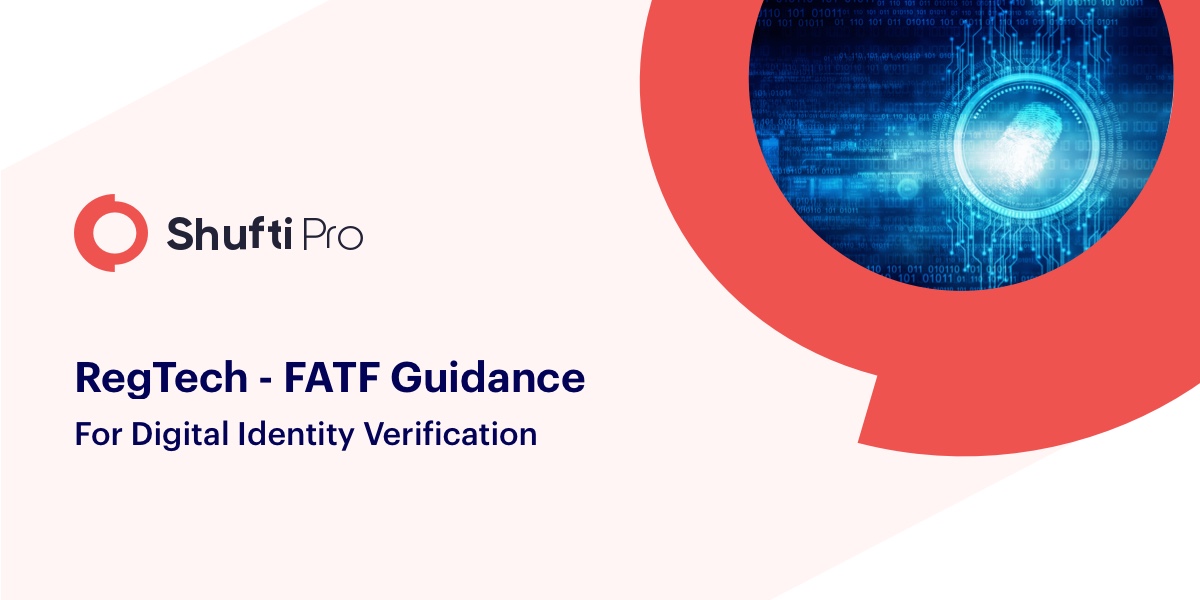RegTech – FATF Guidance for Digital Identity Verification

Regulatory authorities have recognized the benefits of technology and its use for seamless regulatory compliance and scrutiny. Digital identity verification referred to as “digital ID systems” in the FATF guidelines, is a futuristic approach towards fraud prevention. FATF recently issued a guideline for digital ID systems, their use cases, the risks involved and the benefits of such solutions.
FATF took this initiative back in 2017. It showed its positive attitude towards technological solutions for regulatory compliance that are aligned with the regulations of FATF. Since then FATF has been working on developing guidelines for such fintech and RegTech solutions, that will further make this industry fraud-free. As the guideline highlighted that risk prevails in the fintech industry as well and it can be mitigated through regulatory compliance. The FATF guideline on the digital ID systems is still under scrutiny and it requested suggestions for public stakeholders to leave no loophole for financial criminals.
FATF Guideline Key Features
The following are the key features of FATF guidance on digital ID systems. It is expected that the final draft of guidance will be very much different from the current draft.
Stakeholders of the Digital ID guidance
FATF developed guidelines to assist in regulatory compliance, supervision, examination, and cybersecurity authorities by government organizations involved in policymaking. Also, the private sector that delivers digital ID systems will have a lot to gain from the guidance.
Last but not least, the businesses and organizations that use outsourced digital ID systems will also benefit from this guidance, as it will help them to choose the best Digital ID verification solution.
Limitations of the guidance
The guidance draft issued by FATF doesn’t cover any information regarding some Customer Due Diligence (CDD) practices. The guidance doesn’t cover the CDD through digital ID for legal person verification, Ultimate Beneficiary Owner (UBO) screening, and nature of a business relationship.
There is no doubt that digital ID verification can serve these above-mentioned purposes as well but for the time being FATF didn’t cover these in this guidance.
Main components and participants of the digital Identity systems
The guidance mentioned three main components and participants that it seeks to be available in digital identity systems used by the entities. It includes the process of identity screening through digital ID systems, the ongoing screening and the technical aspects of the digital identity systems.
Identity proofing and enrollment is the first component and it involves the collection and verification of customer data. A picture is shown on the 13th page of the guidance draft and it shows the process of collection of data from the official identity document (like ID card) and then screening of the information to verify the identity of a customer. The component one also includes the verification of a person through biometrics like face verification and liveness detection to ensure that the original person is providing the identity evidence.
Identification and identity lifecycle management is the second component and it includes the information regarding the stakeholders that need to be verified. The system should be designed to verify the identity of new customers and to verify the identity of already existing customers. It also mentioned that the digital identity system can be used every time a customer logs in to his/her account online or for every face to face interaction with the customers. Such verification should be performed on all the transactions and events mentioned in the FATF regulations regarding identity verification.
Portability of identity proof is the third component that allows the end-users to develop portable identities that will be issued for future verification.
References
The guidance referred to NIFT Digital ID Guidelines and EU’s EIDAS Regulations and explained how Digital ID systems help in the effective implementation of CFT and AML regulations.
Technical standards
The Digital ID systems that follow the guidelines of following international standard organizations are good to go as per the guideline:
- various jurisdictions or supra-national jurisdictions (e.g. eIDAS Regulation by the European Union)
- International Organization for Standardization (ISO), International Electrotechnical Commission (IEC), Faster Identity Online (FIDO) Alliance, and the OpenID Foundation (OIDF), and
- International Telecommunications Union (ITU) and GSMA (for industry-specific).
To wrap up, businesses are required to comply with KYC, AML and CDD recommendations of FATF in every corner of the world. Now FATF is making things easier for them by developing a guideline for digital ID systems. Just follow this guideline for choosing the best identity verification solution for your business.









